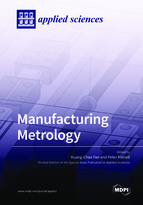Manufacturing Metrology
A special issue of Applied Sciences (ISSN 2076-3417). This special issue belongs to the section "Mechanical Engineering".
Deadline for manuscript submissions: closed (30 April 2021) | Viewed by 69858
Special Issue Editors
Interests: precision metrology; precision machine design; machine tool accuracy
Special Issues, Collections and Topics in MDPI journals
Special Issue Information
Dear Collegaues,
Metrology is the science of measurement, which can be divided into three overlapping activities: (1) the definition of units of measurement, (2) the realization of units of measurement, and (3) the traceability of measurement units. The term “manufacturing metrology” was originally used to indicate the measurement of components and inputs for a manufacturing process to assure that they are within specification requirements. It can also indicate the performance measurement of manufacturing equipment.
This Special Issue welcomes papers revealing novel measurement methodologies and instrumentations for manufacturing metrology from conventional industry to the frontier of advanced hi-tech industry. We are proud to work with a team of skillful editorial assistants and highly efficient and experienced reviewers. Under our services, your research outcomes can be realized in the production of high-quality papers within a short time. Please submit your manuscripts related to, but not limited to, the following areas:
- Precision dimensional measurements.
- New technology or instruments of on-machine measurements.
- In-process dimensional control or error compensation.
- Machine tool metrology.
- Robot metrology.
- Strategic planning of manufacturing metrology.
- Traceability, uncertainty analysis of measurement systems.
Prof. Dr. Kuang-Chao Fan
Dr. Peter Kinnell
Guest Editors
Manuscript Submission Information
Manuscripts should be submitted online at www.mdpi.com by registering and logging in to this website. Once you are registered, click here to go to the submission form. Manuscripts can be submitted until the deadline. All submissions that pass pre-check are peer-reviewed. Accepted papers will be published continuously in the journal (as soon as accepted) and will be listed together on the special issue website. Research articles, review articles as well as short communications are invited. For planned papers, a title and short abstract (about 100 words) can be sent to the Editorial Office for announcement on this website.
Submitted manuscripts should not have been published previously, nor be under consideration for publication elsewhere (except conference proceedings papers). All manuscripts are thoroughly refereed through a single-blind peer-review process. A guide for authors and other relevant information for submission of manuscripts is available on the Instructions for Authors page. Applied Sciences is an international peer-reviewed open access semimonthly journal published by MDPI.
Please visit the Instructions for Authors page before submitting a manuscript. The Article Processing Charge (APC) for publication in this open access journal is 2400 CHF (Swiss Francs). Submitted papers should be well formatted and use good English. Authors may use MDPI's English editing service prior to publication or during author revisions.
Keywords
- Manufacturing metrology
- Quality control
- Dimensional measurement
- Machine tool metrology
- Robot accuracy
- Manufacturing process







